The Yuneec Typhoon H floated away on me, but it's still an incredible drone
It’s drone season, baby.
Let’s review: In April, DJI (the world’s biggest drone maker) released its new flagship model, the Phantom 4 — the first consumer drone with sense-and-avoid technology, so that it won’t fly into obstacles. My review is here.
Then in June, after two years of thinking, the FAA released the rules for commercial drones. It’s pure common sense: Daytime flying only, under 400 feet, no flying over people, and so on. (You can read my full story here.)
And now, there’s even more news: The DJI Phantom 4 has company. In fact, it has an arch rival: the Yuneec Typhoon H.

(Cool-looking drone, but what’s with the company’s name? It’s like calling company Greight, or Turyphic, or Ecksellent.)
But when a rep told me the Typhoon H does much more than the DJI Phantom but costs $100 less, I figured I had to take it for a spin.
The value proposition
The Typhoon H offers most of the same key features as the DJI Phantom, like the ability to avoid obstacles that are directly in front of it — even in low light, since the Typhoon H uses sonar instead of a camera. (Neither drone can avoid things if you’re flying backward or sideways.)
Both drones offer just over 20 minutes of flight time per charge (you definitely want a second or third battery). An incredible 43 mph top speed (when you turn off obstacle avoidance). Stunning 4K video footage. Automated modes for Follow Me, Circle Me, and Automatically Fly a Course I Created Beforehand.
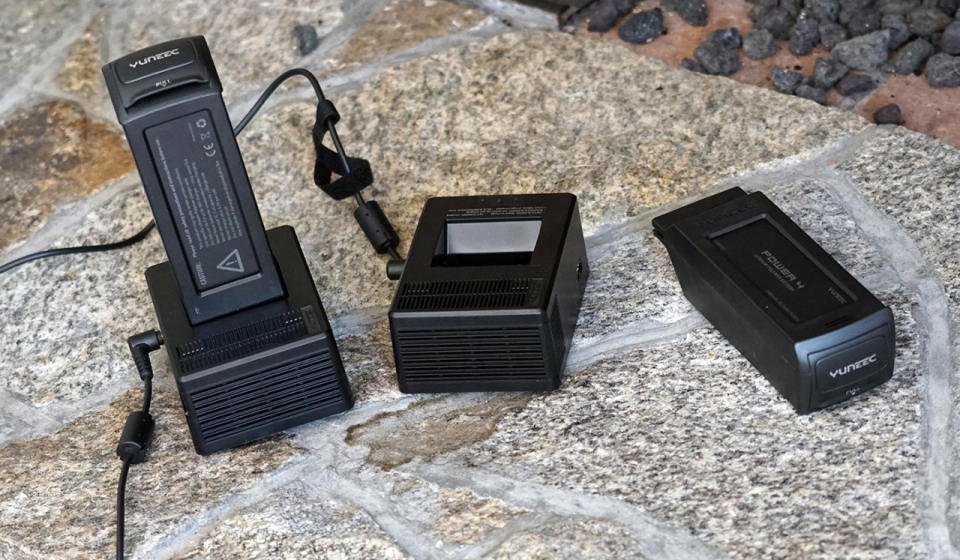
But the Typhoon H offers five huge bullet points that should give the Phantom 4 a shudder of inferiority:
It’s a hexacopter. The Typhoon has six propellers instead of four, supported by carbon-fiber arms that fold down for compact transport. Six rotors means more payload, better speed, and greater stability — you cannot believe how rock-steady this drone is, even in buffeting winds. (”It’s like it’s on a 400-foot tripod,” says one review on Amazon.) And the Typhoon can keep flying on five props if one of the motors fails, although I’m not sure that situation arises often enough to matter.

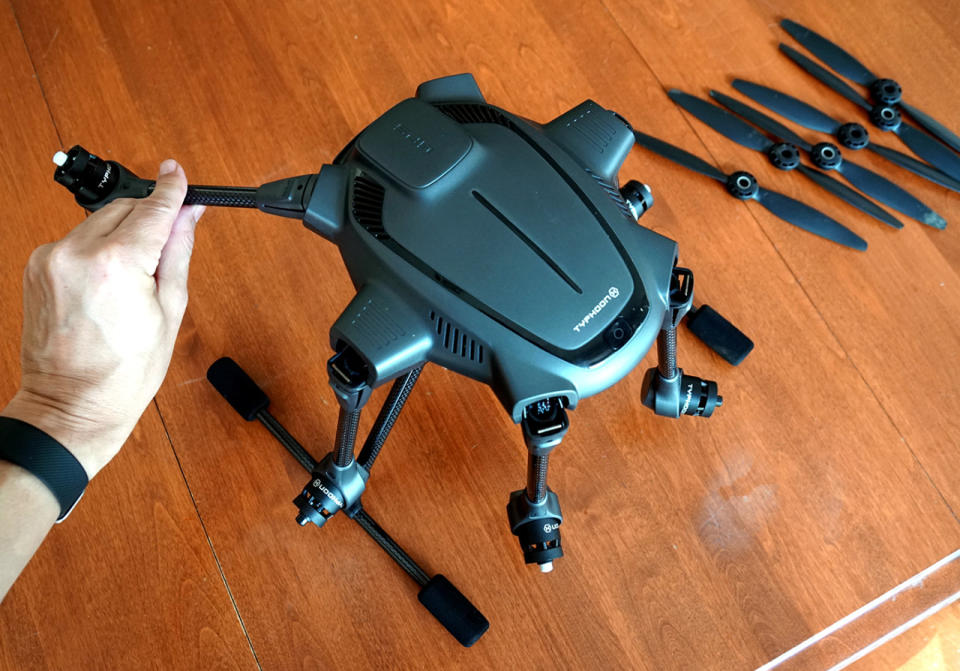
The legs swing up out of the way, and the camera rotates 360 degrees. A switch on the remote makes the landing gear swing up, so that the camera can record the vista from any angle. That’s huge. The DJI Phantom’s camera moves only up and down; if you want to pan right to left, you have to turn the entire drone. The Typhoon H is clearly a superior drone for photographers and videographers, because your camera movements can now be independent of the drone movement.

There’s a separate remote for flying. At the moment, the drone comes with a handheld remote called the Wizard, which lets you control the drone’s flight with one hand. (After the current promotion, the Wizard will cost $200.) That way, you can be the pilot, and someone else, holding the regular remote, can operate just the camera. Splitting up the tasks of flying and filming is a feature usually found only on much more expensive drones; it makes possible far more complex camera moves (and safer flying).
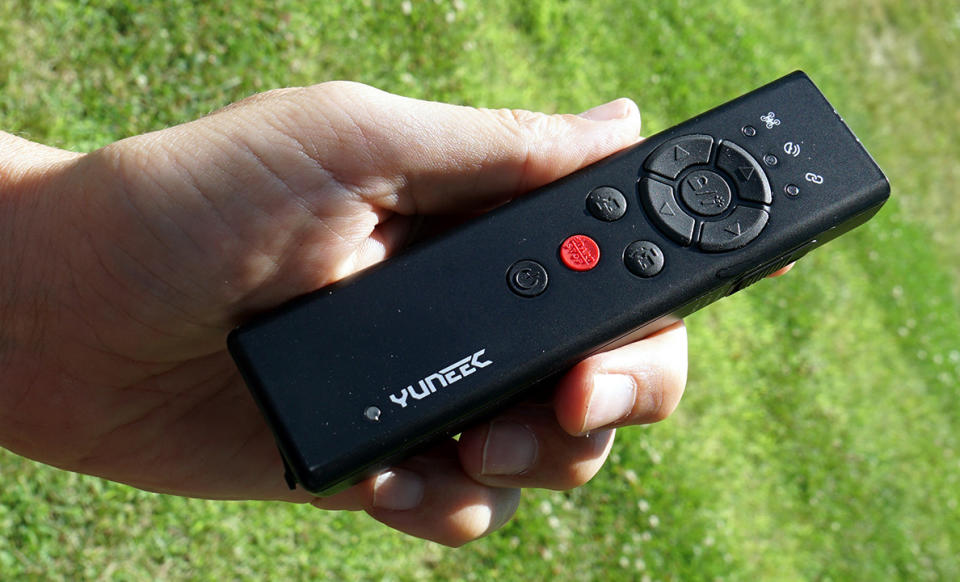
It adds an idiot-proof Smart mode. Let’s see if I can even explain this: In most drones of this type, the right joystick controls the flying direction. But that can be tricky if the drone has gotten turned around in flight. Suddenly, pushing the joystick forward doesn’t fly the drone forward; it may zoom in some totally unexpected direction, depending on where the nose is pointing. But in Smart Mode, the drone always flies the way you’re pushing the stick, no matter which way the drone is facing. It’s ingenious. (Smart Mode also introduces other safety features — for example, it won’t let the drone fly directly over you.)
It doesn’t need a tablet. If you buy a DJI Phantom or 3DR Solo, it’s BYOT: bring your own tablet. That’s your screen. That’s how you see what the drone sees. But the Typhoon’s remote has a 7-inch touchscreen— no tablet needed. That’s one less thing to buy, pack, charge and hook up every time you fly. (You can connect a tablet if you want to.)
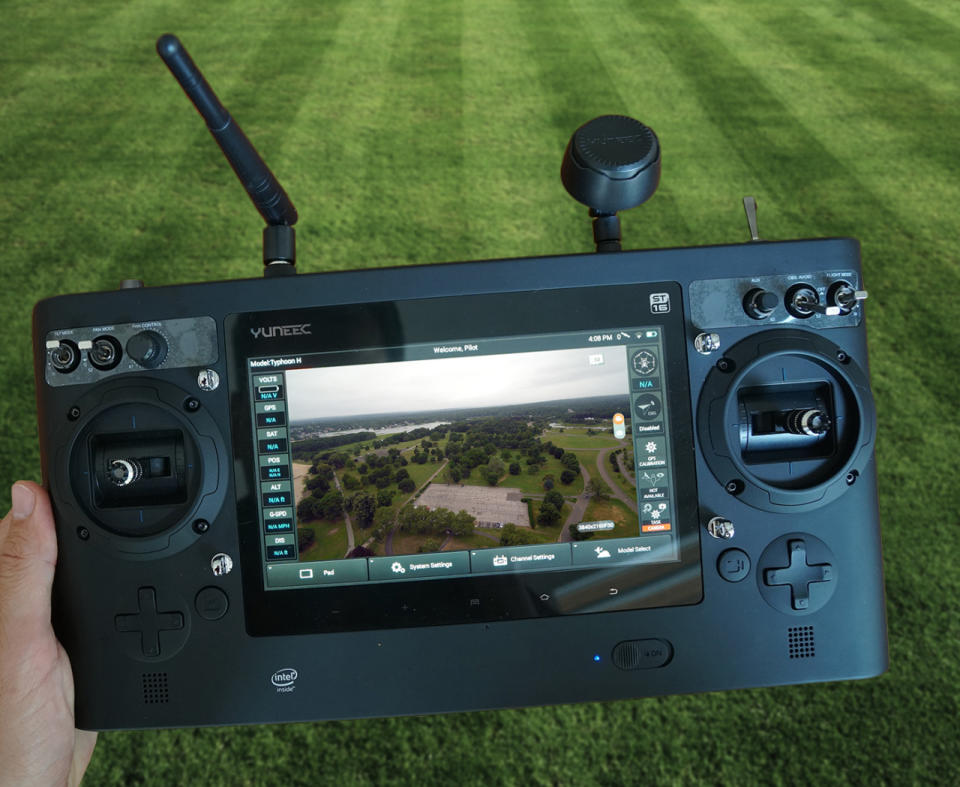
As it turns out, the Typhoon H remote is a full-blown Android tablet. With one touch, you can exit the flying app and find yourself with regular apps—email, web browser and so on. That can be handy, as I discovered one day when the drone’s memory card ran out of space while I was miles from home. I transferred the card from the drone to the remote, and, using the Android file manager, deleted some recordings I no longer needed.
All of this makes the Typhoon H a ridiculously powerful, flexible eye in the sky —at a price $100 lower than its arch-rival.
The not-so-fine print
Before you reach for your Visa card, though, some cautions are in order.
First, the DJI Phantom is better at some things. For example, it can use object recognition to follow and film you as you ski, bike or run. To pull off a similar stunt with the Typhoon H, you have to carry either the huge, bulky remote (hard to do biking or skiing!) or the Wizard wand to use as the homing device.
The DJI’s range is also much longer than the Typhoon H. Technically, you’re not supposed to fly any drone beyond what you can see, so this point may be moot— but DJI claims a range of 3 miles for the Phantom, versus 1 for the Yuneec.
And speaking of FAA rules: The DJI can fly higher than the FAA-regulated 400-foot altitude limit. The Yuneec, on the other hand, is hardwired to stop at 400 feet. Too bad if you were hoping to inspect a tower, building or mountain taller than that — which is perfectly FAA-legal.
You can override the Typhoon H altitude limit, but only by using an obscure Windows-only app on Yuneec’s Web site.
The complexity problem
Despite the brilliance of Smart Mode, the Yuneec drone feels more advanced than DJI’s Phantom. But more options (and there are hundreds) mean more complexity, and it will take you many flights to master them. There is, of course, no printed user guide — only a Quick Start pamphlet. Hope you like PDFs.
The upper-left corner of the remote, for example, contains four controls for camera movement. A knob for panning, a rocker for tilt (from straight ahead to straight down), a three-position switch for panning mode, a second switch to choose the tilting mode. (The choices are Angle Mode and Velocity Mode. Surely you know what those mean.)

The black, spidery Typhoon looks sleek and militaristic — and it’s festooned with colorful lights.
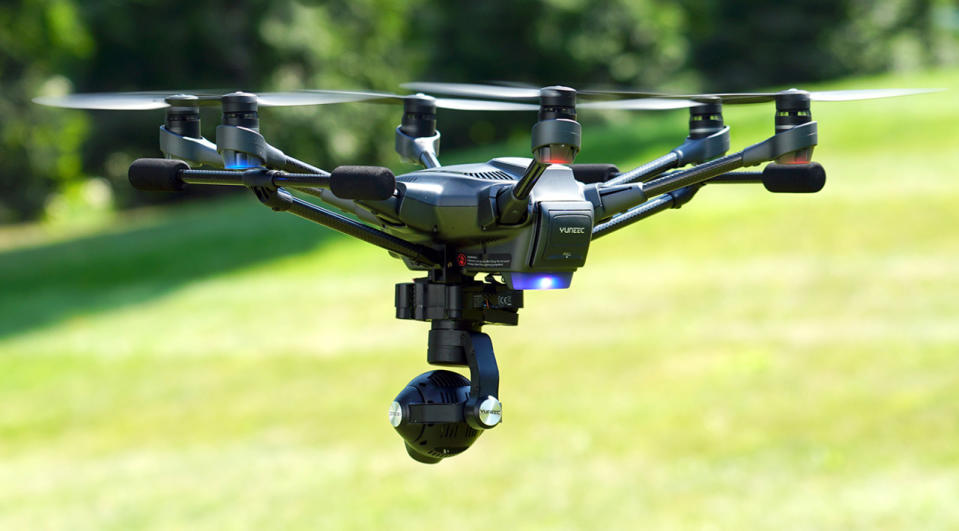
They’re not just pretty, though; they’re supposed to give you status information. But trying to figure out what their colors and blinking patterns mean practically requires a secret decoder ring:

In general, this drone doesn’t always have its act together. It takes a long time to start up — over two minutes. During my testing, Smart Mode sometimes didn’t kick in until I’d flipped its switch off and on again.
The drone isn’t as sturdy as its rival, either; the camera module popped loose from its gimbal with only the slightest bump, and even when I tried to extract the drone from its Styrofoam packaging. (Other customers mention this gimbal-disconnection problem, too.) Getting the gimbal threaded back onto the four rubber bulbs that are supposed to hold it in place took 20 minutes of tedious fussing with tweezers each time.
My flyaway
Last week, I was flying the drone over my house. Good battery charge, 370 feet up, direct line of sight — and then, before my eyes, it started drifting away. The joysticks did nothing. The screen just said, “Trying to reconnect.” The drone floated away. There was nothing I could do.
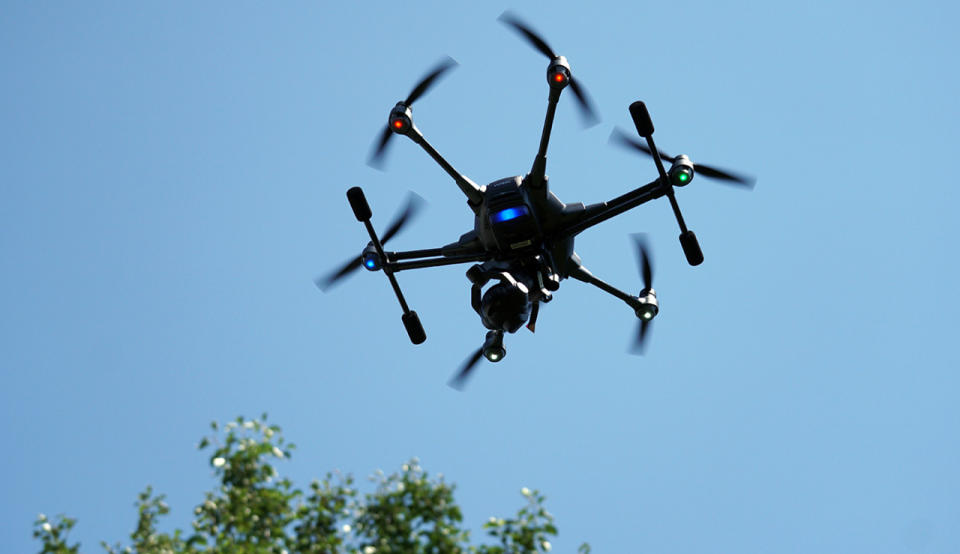
I got on my bike and rode around, looking and looking — but I never found it. At this moment, there’s a $1,300 drone in somebody’s bushes somewhere.
So I Googled it: “Typhoon H flyaway.” Turns out I’m not the only one! Wow —had I uncovered a fatal flaw?
But then I thought: Maybe this problem isn’t unique to the Yuneeq! I Googled “DJI Phantom 4 flyaway,” and guess what? Flyaways happen to that one, too! There are YouTube videos aplenty, showing drones drifting away forever — if you can bear to watch them.
Here’s what I don’t understand: All of these high-end drones have a fail-safe Return to Home feature. As soon as the drone loses its connection to the remote, for whatever reason, it automatically returns to its takeoff point. I’ve tested this feature many times — I’ve turned off the remote to show friends and family how well it works.
And yet, even so, flyaways occasionally happen. Remember the one that landed on the White House Lawn? (Fortunately, nobody’s ever been seriously hurt by a flyaway drone. Yet.)
After studying the log files extracted from my remote control, a Yuneec technician confirmed that I’d done nothing wrong, but said he had no idea why the drone flew away. We’ll never know exactly how my flyaway happened, but I was really rattled by the experience.
Flying high
No other reviewer has experienced a flyaway, and the second Typhoon the company sent me had no such problem. Since flyaways are clearly a rare possibility, and since any drone brand is vulnerable, I’m going to heave a sigh here and avoid letting my freak experience color my Typhoon conclusions. Which are:
Among advanced consumer drones, it’s clearly the value king. Eliminating the separate iPad saves you $500 or so right there. The 360-degree camera rotation feature, and the separate wand for piloting, should be pure gold to filmmakers. The company itself gets rave reviews for its customer service; the kit comes with a wealth of included accessories (shoulder straps, car charger, sun shade for the screen, etc.). And it would be hard to imagine a drone with more options to tweak and customize.
From a features standpoint, this drone flies circles around the DJI Phantom 4, too.
Just remember that the Typhoon H’s personality is complex and sometimes opaque. It may be the Stradivarius of semi-pro drones — but that just means you’ll have to practice that much harder.
David Pogue is the founder of Yahoo Tech; here’s how to get his columns by email. On the Web, he’s davidpogue.com. On Twitter, he’s @pogue. On email, he’s [email protected]. He welcomes non-toxic comments in the Comments below.